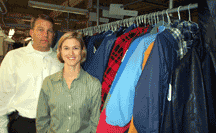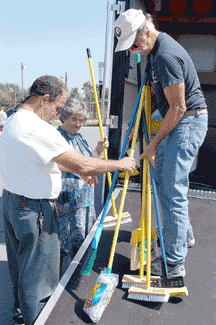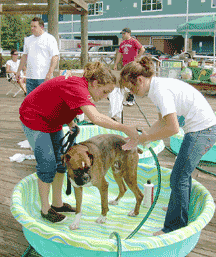|
|||||||||||||||||||||||||||||||||
|
|||||||||||||||||||||||||||||||||
Measuring Business Success in More Than ProfitsPoor, ill or flooded out, many will benefit this season from the generosity of Chesapeake businessesby Carrie Madren, Bay Weekly Senior Staff Writer
|
|||||||||||||||||||||||||||||||||
 |
|
Caterina Borg, top left, tithes a share of the profits from her bakery to area charities. Barbara Sturgell, below, donates food to community causes and for Thanksgiving dinners. |
A family lesson taught Sturgell to give.
“I was raised that way,” she says. “At Christmas and Thanksgiving, my mother used to fix bushel baskets of food for people. She always said before we think about giving to ourselves, we have to fix a basket of food for someone else.”
The recipient of that holiday basket was a next-door neighbor raising grandchildren.
“We also sewed a lot,” Sturgell adds. “We made them clothes out of flour sacks or corn sacks.”
Other business owners hone their sense of giving at school.
While studying for her Master’s of Business Administration at Loyola College in Maryland, Borg took a class on corporate social responsibility.
Her class took her to Chile and Argentina, where students visited both for-profit corporations and non-profits. Borg learned her lesson at Hogar de Cristo, Christ’s Home, founded by a priest in the 1930s to help homeless people. The refuge has expanded to include a mental hospital for poor and homeless women. Borg was touched by the pure philanthropy of the non-profit, and expects some day — after taking care of community needs in Anne Arundel County — to help support the Chilean mission with funds from her Sweet Missions.
“Businesses are finding that they do have a responsibility to be charitable,” says Lindsay Siegel of the Committee to Encourage Corporate Philanthropy, a New York-based organization that encourages and teaches mid- to large-sized companies that there’s more to charity than writing a check.
“Companies are supported by the community, and that’s what makes them successful. So it’s in their best interest to provide programs where they give back,” Siegel says.
Writing a check is good, Siegel says, but being strategic in donations will help a business as it gives to charity.
Siegel’s group encourages companies to develop giving programs that use goods and services that they already have, “leveraging something they already had strength in,” she says. In that way, donating may not drain a company financially but can still do a lot of good in the community.
Strategic giving includes finding a need that relates to their trade.
Thus dry cleaners — like Zips Dry Cleaners and Admiral Cleaners — are well placed to collect coats from their customers for charities.
Zips collects garments of all kinds throughout the year, while Admiral collects coats during the fall for non-profits like the Salvation Army and Centro de Ayuda so cold people can get outfitted with a new coat.
“There’s been a growth in the Hispanic population, and they’re coming from warmer climates where winter coats weren’t something that you needed,” says Admiral Cleaners’ co-owner, Whitney Kerridge, whose company performs some $10,000 worth of cleaning for the coats donated in its annual drive. In 2004, they collected some 5,000 coats from customers in 22 branches. This year, they’ve already tallied 3,200.
Pure Philanthropy
 |
|
Admiral Cleaners owners Scott and Whitney Kerridge collect coats for the Salvation Army and Centro de Ayuda. “There’s been a growth in the Hispanic population, and they’re coming from warmer climates where winter coats weren’t something that you needed,” Whitney Kerridge said. |
Businesses reach out to communities for reasons ranging from good publicity to good will. In the mix of motivations, spontaneity is often the spark.
For Ron and Marilyn Snyder of Ron Snyder Antiques on West Street in Annapolis, seeing a serious need — flood victims faced with the daunting task of cleaning up their homes — urged the antique dealers to pack up their own trucks and trailers with cleaning supplies and head to the disaster.
“We are doing well in business and in our lives, so we need to give back whenever possible,” says Marilyn Snyder, who says they traveled on their first mission with supplies to Ohio, where they located a church to help distribute the bleach, buckets, mops, scrub brushes, masks and more that they’d bought to give to flood victims in need. The Snyders buy much of the materials they donate with their own money, though they’re working on setting up a non-profit fund.
When Hurricane Isabel struck the East Coast in 2003, the Snyders had flood damage in their own home and the basement of their business. But that didn’t keep them from hitting the road to help others.
“We finally said let’s just go,” says Marilyn. They packed up their truck with cleaning supplies they’d charged to their credit card.
Other charity work becomes an annual tradition. Serving an annual free Thanksgiving dinner to the Solomons community is so ingrained that Lighthouse Inn owners Richard and Susan Fischer are doing it again this year — despite the summer fire that burned down their restaurant.
The annual dinner organized by SMILE — a non-profit made up of nine Southern Maryland churches to provide food, clothing and more to needy people — is a melting pot of contributions. The Fischers spend months securing donations from their food sellers to ensure that hundreds of seniors, homeless and lonely people enjoy a Thanksgiving feast year after year. Then they make up the difference. In the past they have also contributed the venue; this 16th year, Catamarans Restaurant will take on the hundreds who flock to eat.
Chefs at Catamarans, owned by James Seymour, had to rearrange the freezer to accommodate the 400 pounds of turkey bought by Richard Fischer.
“It doesn’t have anything to do with the business,” says Susan Fischer. “We want to help people.”
Making Good Business Sense
 |
Ron Snyder, left, of Ron Snyder Antiques, buys cleaning supplies and other supplies, loads them onto his truck and drives to disaster sites to offer aid. |
 |
|
Charity is good business because it returns a share of goodwill.
“To our business, giving makes good sense,” says Whole Foods’ spokeswoman Diana Love. “Last week we gave floral arrangements to Severn River Trust [for an event]. These people are going to say, Wow! These flowers came from Whole Foods. Hopefully people will want to get their flowers at Whole Foods.”
The grocer also gave organic apples and nutrition bars to a Key School event. Besides getting the word out about healthy eating to students, says Love, “I want to reinforce that organic image [of Whole Foods] in the community.”
Charitable companies, in turn, attract charitable customers.
“People are more inclined to want to support someone who cares,” says cookie baker Borg. Having the charity fund “puts us in a better light,” she says. “People see this is who we are.”
Mattress manufacturer Dormia donated 19 sets of mattresses to the Odenton Volunteer Fire Department at the request of an employee whose husband works as a first responder at the Odenton station.
Besides the mattresses being much needed at the station, “it’s good public relations,” says Dormia’s chief executive officer Michael Zippelli, who hopes that potential buyers will recognize the mattresses and remember the name of the company they read about that donated to their local fire department.
“Plus it’s good morale for the company,” he says. “People who work here can see more [happening] than making money.”
The Currency of Giving
The three main values that businesses give are money, time and goods.
As well as sharing the bounty of its products, Whole Foods supermarket donates five percent of its annual sales to area charities in half a dozen ways, ranging from cash donations to teaching the community about healthy eating. The biggest contributions come from their Five Percent Days, four days a year when all the day’s sales raise money for charities chosen by application.
To help Tails of Hope Sanctuary raise $10,000, Whole Foods sponsored a Chip & Dip Day, where dog owners could get Fido microchipped and bathed. Passed along, their donation enabled the animal care center to buy medicine for their animals.
From September 2005 to September 2006, Whole Foods gave $35,000 to charities during such Five Percent Days, plus another $25,000 in other fundraising efforts, including Thanksgiving meals for needy families last year.
A woman whose Thanksgiving dinner was provided by Whole Foods via Rotary of Annapolis wrote her thanks to Love.
“My dream was to make a dinner for my family. This is the first time I could sit my family down and have a holiday meal,” she wrote.
Whole Foods also helped Rotary of Annapolis buy dinner for 23 families through Sarah’s House. “If you have the capacity to help someone, you should,” says Love.
A second way businesses give is by donating time, which could be spent making money, to help others.
At Scalped Salon in Prince Frederick, owner Margaret Thompson includes three mandatory volunteer hours every month in each employee’s contracts. Staff can use those hours cutting hair for a dying cancer patient, trimming up a person with mental disabilities for a job interview or any other charitable work done while on the clock.
Donated time also comes from lawyers and law offices who counsel pro bono every year, giving thousands of dollars worth of legal counsel for free. Lawyers licensed to practice in Maryland should donate 50 hours of charity or public interest legal service each year, performing most of those services for no fee or a reduced fee, according to the Pro Bono Resource Center of Maryland.
The final offerings are tangible, like Barbara Sturgell’s food from Happy Harbor or toys donated by customers and dropped off at area business in benefits organized by groups like Toys for Tots.
Magnifying Good Will
 |
|
Whole Foods Market donates Thanksgiving dinners to those in need, and they raise money with fundraisers like their Chip & Dip Day, where dog owners can get Fido microchipped and bathed, with the proceeds going to charity. |
Businesses that rely on their customers to help raise money or collect donations can increase their goodwill by involving more people. Like a magnifying glass, such companies solicit money or donations from their clients and focus many customers’ contributions into a larger do-good effort.
Last summer, Zips collected more than 7,100 garments for Suited to Succeed, and more than 10,000 garments for the Goodwill Campaign in January of 2007.
“We couldn’t be successful with these projects if it weren’t for our customers,” says owner Jole Levine.
At Rod ’n’ Reel’s Cancer Gala, a fundraising party thrown by owners Gerald, Fred and Mary Donovan and their staff of volunteers, thousands come to feast on lavish buffets. Some 1,800 pay $125 and more for tickets to fight cancer and feast each summer, annually raising more than a quarter million dollars for the American Cancer Society’s research. This year’s Cancer Gala raised $467,500, $100,000 more than was raised in 2005.
Likewise at Scalped Salon, help “definitely comes from the clients. They write their checks to Hospice,” says owner Thompson. “People are willing to give, but lots of times people just don’t get asked.”
Seeing Rewards
Companies that give rarely win awards, though Sturgell has been honored with the Gene Hall Award, which recognizes a community benefactor who does good in Southern Anne Arundel County.
“We feel like we can’t cure world hunger,” says Scalped Salon owner Thompson, whose outreach includes making house calls to terminally ill patients at Calvert Hospice. “But we can make someone feel so much better with a haircut.”



